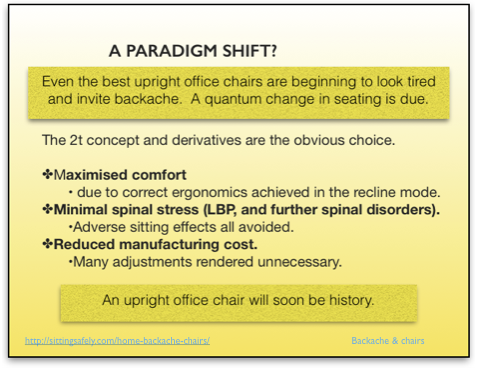The responsibility …
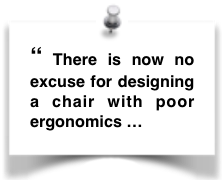 From a medical perspective designers of ergonomic chairs have a serious responsibility. The prevalence of Low Lumbar Backache, the mildest in the spectrum of spinal dysfunction, and more general health issues, associated with prolonged sitting, is still high. and their first concern should be the Hippocratic Primum non nocere “Do no harm”.
From a medical perspective designers of ergonomic chairs have a serious responsibility. The prevalence of Low Lumbar Backache, the mildest in the spectrum of spinal dysfunction, and more general health issues, associated with prolonged sitting, is still high. and their first concern should be the Hippocratic Primum non nocere “Do no harm”.
The problem ..
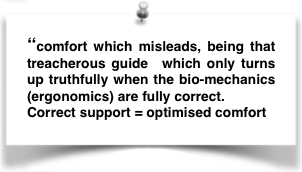 Familiarity bias makes it difficult to recognise the underlying bio-mechanics for a chair that can in due course result in spinal problems. There is a tendency to be misled by Comfort which is only improved the nearer a full remediation is approached. (Full remediation = maximum comfort).
Familiarity bias makes it difficult to recognise the underlying bio-mechanics for a chair that can in due course result in spinal problems. There is a tendency to be misled by Comfort which is only improved the nearer a full remediation is approached. (Full remediation = maximum comfort).
A warning
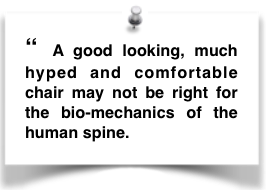 To sell ergonomic incorrect chairs for prolonged use, when the knowledge is generally known, will become unacceptable. Even contemporary chairs which claim huge ergonomic advantages are, at best, partial remediations. The existing ‘cool’ upright models will be superseded Many have often been designed without understanding of the scientific evidence and may actually become potentially adverse. An example is the misapplication of the ‘pelvic posture principle’. →
To sell ergonomic incorrect chairs for prolonged use, when the knowledge is generally known, will become unacceptable. Even contemporary chairs which claim huge ergonomic advantages are, at best, partial remediations. The existing ‘cool’ upright models will be superseded Many have often been designed without understanding of the scientific evidence and may actually become potentially adverse. An example is the misapplication of the ‘pelvic posture principle’. →
The resource
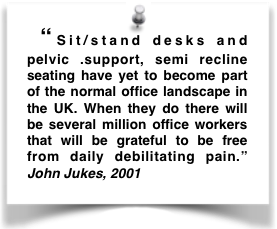 This work merely gives an account of the ergonomic factors that can result in spinal dysfunction and their possible ergonomic remediation, and provides the resource for their understanding. These are mainly partial, for existing upright chairs. A full potential remediation system is also described which can be configured in a number of different ways,providing that the principles are observed.
This work merely gives an account of the ergonomic factors that can result in spinal dysfunction and their possible ergonomic remediation, and provides the resource for their understanding. These are mainly partial, for existing upright chairs. A full potential remediation system is also described which can be configured in a number of different ways,providing that the principles are observed.
Before proceeding,
Be sure to have read ☛The upright seated posture.→
and have a look at an examples of misconceived advice :-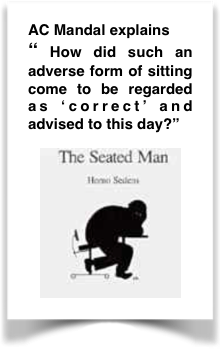
- The Seated Man (Homo sedens).1985. Dafnia Publications, ☛ Homo sedens→)
- Recent scientific work on spinal pathology and biomechanics show that these ‘correct’ details are seriously adverse to spinal well being. See adverse effects of ☛mid-upright seating→
- Pressure studies alone show that upright sitting itself is seriously adverse ☛ Loading→
 There is now no excuse for poorly designed chairs and the conventional mis-advice that is perpetuated. Mandal ‘The Seated Man’→
There is now no excuse for poorly designed chairs and the conventional mis-advice that is perpetuated. Mandal ‘The Seated Man’→
For detailed accounts
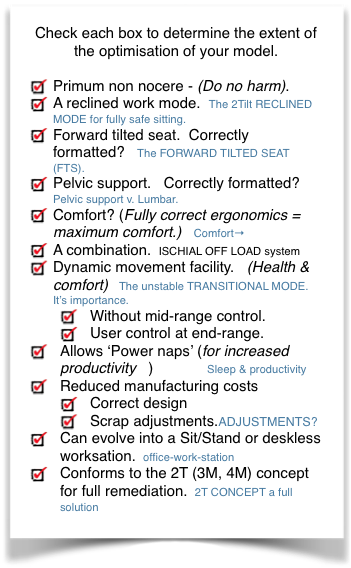 The FORWARD TILTED SEAT (FTS) →
The FORWARD TILTED SEAT (FTS) →- BACKRESTS. Pelvic v. Lumbar. →
- ISCHIAL OFF LOAD system →
- 2T CONCEPT a full solution →
- OFFICE WORK-STATIONS→
- ADJUSTMENTS? →
- The unstable TRANSITIONAL MODE. It’s importance.→
- COMFORT →
- REMEDIATION→
How ‘ergonomic’ are your designs? How many boxes do they tick?
- I have tried to avoid unkindly designating most work chairs as ‘Machines for making Backache’. ☛HOW WE SIT NOW→
- There is no chair on the market, at present, that can be recommended for prolonged sitting. ☛Various chairs. How do they measure up? →
- Backache (LBP & other disorders) are still prevalent. ☛ Prevalence and economic cost of LBP.
- At huge cost to industry,the nation and individuals.
- Ergonomic chair design seems to have come to the end of the road with some, but not great, success in avoiding Low Lumbar Backache (LBP). A new ‘fix’ is in order.
- So far, remediation of the upright sitting mode has mainly been considered. This becomes largely irrelevant if a ‘reclined mode’ is adopted
- A new fix is practical. Bio-mechanics (ergonomics) show that a reclined work mode is essential for prolonged work. ☛ reclined work mode→
- A reclined work-chair involves essential requirements to be fully functional.
- A fully practical solution can be effected by the 2T CONCEPT a full solution → A ‘paradigm change’?
Part 2. See introduction to the reclined work mode. →
May I be so bold as to suggest that….
- Ergonomic chair design seems to have come to the end of the road without huge success in avoiding LBP.
- A new ‘fix’ is in order and can be effected by the 2T concept. A ‘paradigm change’?
- This can only be achieved by an understanding of the biomechanics. It is hoped that this work may provide you with this, a resource describing the requirements for safe design.
- By incorporating the points made in this work, comfort and ergonomics of both the simplest and most advanced ‘ergonomic’ chairs should be improved .
- You must not be misled by ‘comfort’, that treacherous guide which only turns up truthfully when the bio-mechanics (ergonomics) are fully correct. See ☛ Comfort→
- Remediating the ergonomics is more important. Comfort is improved the nearer a full remediation is approached. Full remediation = maximum comfort.
- The correct search should be for the Hippocratic “Do no harm”.
- Bio-mechanic adverse designs can be avoided. Why? Mandal’s Homo sedens→
- There is now no excuse for poorly designed chairs and the conventional mis-advice that is perpetuated. ☛ Various chairs→
- Some selling points to manufacturers and architects are added if required.
- The comment of Kenichi Ohmae (below) is apposite.

